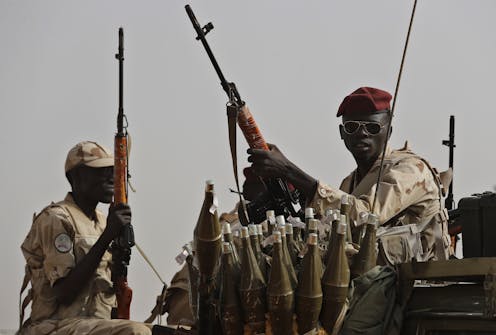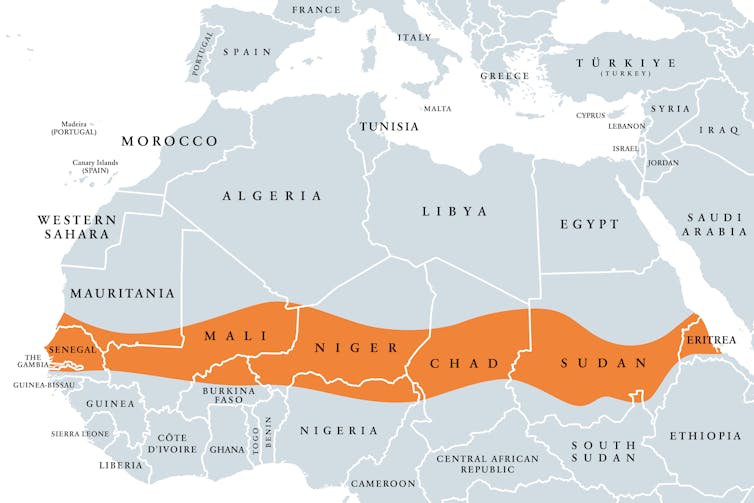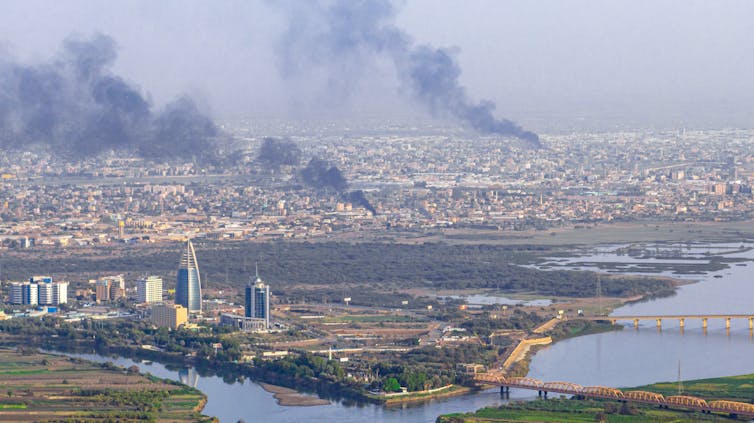Amid humanitarian crisis and ongoing fighting, Africa’s war-scarred Sahel region faces new threat: E
Outside fighters are not merely mercenaries – they are participants in a deeply rooted, historically complex struggle for resources.

Sudan’s ongoing humanitarian crisis after more than a year of civil war shows few signs of abating. And amid the fighting, a significant and troubling development looks set to complicate the conflict and spread it beyond Sudan’s borders: the rise of “ethno-mercenarism.”
That is, soldiers of fortune recruited on the basis of ethnic affiliation, or driven by economic motivations, who have been heading to Sudan from across Africa’s Sahel region, the vast semi-arid area of the continent separating the Sahara Desert to the north from the more fertile tropical regions to the south.
The involvement of non-Sudanese Arab fighters in Sudan’s civil war has impacts far beyond the country’s borders and highlights broader sociopolitical and economic trends across the African continent. As a researcher following the developments shaping political transitions in countries along the Red Sea, I believe that understanding the complex dynamics drawing outside fighters into Sudan’s civil war is crucial to comprehending the larger geopolitical shifts that are shaping the region.
Migrations, climate change and resource scarcity
The war between the Sudanese Armed Forces and the paramilitary Rapid Support Forces broke out in April 2023 after the support forces, which until then were under the control of the armed forces, attacked government positions in the capital, Khartoum. It quickly descended into bloody fighting across the country between the two rival groups.
It is not just a local concern but increasingly a regional one. Fighters from Chad, Libya and Niger have joined the support forces, indicating a web of alliances that challenge traditional notions of national sovereignty and security.

This cross-border involvement underscores the interconnectedness of the Sahel region. And the fighters involved are not merely mercenaries – they are participants in a deeply rooted, historically complex struggle for resources and power that has pitted ethnic groups in the region against each other.
The recruitment of outside Arab fighters by the Rapid Support Forces – a group that developed out of the Janjaweed militia responsible for massacres across the Darfur region – is influenced by multiple factors, including historical migrations and economic pressures.
The legacy of pan-Arabism and Arab supremacy ideology, propagated by figures such as slain Libyan dictator Moammar Gadhafi, plays a part. It intertwines with contemporary issues such as climate change and resource scarcity to create a volatile environment in which traditional governance structures have struggled to maintain order. Since the 1960s, there have been civil conflicts in Chad between tribal movements and in Sudan between Darfur’s rebel groups and the central government in Khartoum.
But understanding the rise of ethno-mercenarism in the Sahel requires a comprehensive approach that considers historical, sociopolitical and economic dimensions.
The Arabization of Sudan
In his 1954 ethnography “The Sanusi of Cyrenaica,” British anthropologist Edward Evans-Pritchard captures the nomadic spirit of an Awlad Ali tribesman in the northern Sahel region: “We call no place our home. It is wherever there is grass and water.”
Arab influence reached Niger and the West Sahara by the 14th century through trade routes, leading to intermarriage with local communities. In eastern Chad, Arabized communities have ties to Sudan, where Arabization dates back to early Islam. Except for the Rizeigat Baggara tribe with ancient land rights in Darfur, Arab nomads in the Sahel have, since precolonial times, been in constant movement.
Factors such as land disputes and desertification – the process by which fertile land becomes desert – have historically driven the movement of Arab tribes across national boundaries. These tribes, having migrated during the French and British precolonial era, have long-standing ties that transcend modern political borders, complicating the simplistic narrative of an internal civil conflict.
And severe droughts in the early 1980s have worsened disputes over resources.
For instance, decreasing rainfall and land degradation in Darfur forced Arab groups to move south, intensifying competition with indigenous farmers. Heavy immigration from northern Darfur and Chad into central farming areas contributed to a famine in 1983-84 that caused thousands of deaths.
The Baggara Belt, spanning from Sudan to Niger, also challenges colonial borders. Migration led to traditional institutions managing land disputes, but colonial and postcolonial laws often worsened conflicts by depriving nomadic tribes of land rights. National postcolonial governments further fueled these conflicts by arming tribal militias in the face of weak national armies.
Postcolonial dynamics
The history of cross-regional ties among tribal groups used to migration across borders in search of resources has provided the backdrop to conditions in Sudan today, in which ethno-mercenaries are being drawn in to the conflict.
But it isn’t only the flow of people that has complicated modern conflict in the Sahel. So too has the flow of weapons.

The influx of modern rifles into Darfur from Libya in the 1970s fueled the violence. Meanwhile, the conflict in Chad from 1978 to 1982 led to government disintegration and advanced arms inflow. In Darfur, arms traded with commercial middlemen, primarily the Zaghawa people, overwhelmed Sudanese police. The Sudanese government armed Baggara Arabs in the mid-1980s to counter the rebel group SPLA, leading to tribal militias attacking neighboring regions.
This flow of arms disrupted peace, stability and traditional norms. The principle of “diya” – blood money paid to unintended victims or their families – managed to limit the violence, but modern weapons increased killings, making blood money unaffordable. Nazirs, who are the traditional tribal chiefs, lost control over armed youth in Sudan in the 2000s, leading to an uptick in violence.
More recently, adding to growing concerns about the region, a new report documents how Jihadi fighters operating in the Sahel region have begun to move into wealthier West African coastal nations such as Nigeria and Benin. In addition, the RSF’s rise and their attacks on Khartoum’s high-security federal prisons have resulted in terrorists joining their ranks in the war.
Addressing the regional turmoil requires a nuanced understanding of these dynamics and coordinated efforts to promote stability and development in the Sahel region.
The rise of the RSF’s ethno-mercenaries threatens to further destabilize an already volatile region. While it is crucial to halt cross-border ethnic recruitment, a comprehensive approach is needed to address the core causes of this dangerous phenomenon: climate change, the flow of arms and poor governance.
Yasir Zaidan does not work for, consult, own shares in or receive funding from any company or organization that would benefit from this article, and has disclosed no relevant affiliations beyond their academic appointment.
Read These Next
Drones, physics and rats: Studies show how the people of Rapa Nui made and moved the giant statues –
The mysteries of Easter Island, subjects of speculation for centuries, yield to scientific inquiry.
A year on, the Israeli-Lebanese ceasefire looks increasingly fragile − could a return to cyclical vi
Since the start of the truce on Nov. 27, 2024, there have been thousands of Israeli violations inside…
Absence of evidence is not evidence of absence – and that affects what scientific journals choose to
Researchers design studies that might disprove what’s called their null hypothesis – the opposite…






